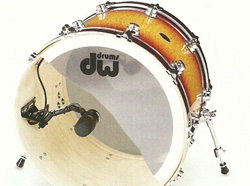
Q: I’ve been recording and mixing a Christian band the past few months and everyone is really happy with the results except for one thing: the kick drum.
Is there anything I can do? Or, if there isn’t, what should I know so I don’t have this problem ever again?
A: While there are a limited number of solutions to your problem once the instruments has been tracked, lets run through our top six tips for recording and then mixing a great kick drum.
First, and probably most obvious is to experiment with mic placement during tracking. Try to get as close to the sound you want with the mic before you add any EQ.
Take a look at where the drum beater is contacting the head, and mic to capture that attack. How far in or out of the drum you place the mic will have a large effect on the tone you capture. Further out will give you a more “resonant” or “woody” tone, while closer up should give you more attack, with less of the drum’s shell.
Second, try miking from the beater side of the drum in addition to your normal kick drum mic placement (assuming you are currently miking from in front of or inside the drum). This should give you more attack.
A few caveats: Watch for phase problems, be careful with mic placement and pickup pattern to avoid getting too much of the underside of the snare, and be sure that the kick pedal is squeak free!
Third, try using a different beater. One made of a harder material may give you more slap. We’ve even heard of drummers and engineers taping hard materials to the kick drum head where the beater strikes it to emphasize the “click” and beater attack.
Fourth, take a look at your musical arrangement. Are there other instruments in the kick drum’s frequency range that are masking it, diminishing its punch? Getting a kick drum and a bass guitar or bass synth to “sit” together in a mix is a real art. Maybe the problem is not in your kick, but in the bass EQ?
Fifth, try adding a little EQ. A parametric (or console EQ with sweepable mids) works well for this application, but a graphic can work fine. Boost the gain on the EQ, listen to the kick, and slowly sweep the EQ frequency until you find the frequency you want to bring out.
Next, adjust the EQ gain to your taste. In addition to boosting some frequencies, you might want to experiment with cutting some of the boomier frequencies out to clear the top end a bit.
And finally (or, some might say sixth) as you are trying various things, work at low volume levels. If the kick drum sounds good to you at low volume, it will probably sound even better when the level is wound up a bit.
For more tech tips go to Sweetwater.com















